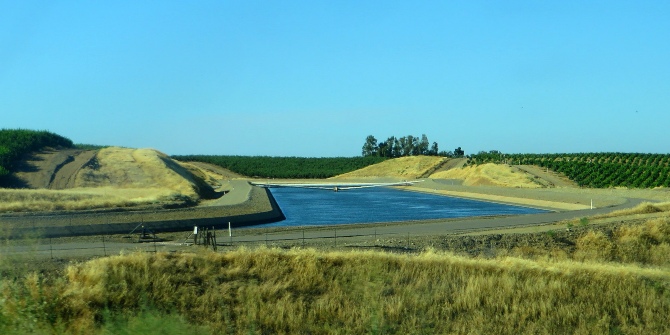The 2007-08 financial crisis shocked financial markets, making them much more averse to risk and less willing to invest. In new research Michiel N. Daams, Philip McCann, Paolo Veneri, Richard Barkham, and Dennis Schoenmaker document the geographic effects of capital markets’ increased risk aversion. They find that in the wake of the financial crisis, capital markets switched from being largely indifferent to what type of city they invested in to favoring already large and wealthy centres such as New York and San Francisco. This “flight to safety”, they write, has reoriented the economic geography of US growth in a way that disadvantages cities and regions in the US ‘heartland’.
In economic terms, urban and regional productivity and prosperity differences not only run deep across the US but have also, as the OECD has documented statistically, been widening over recent years. After more than a century of convergence between regions, the US has recently shifted to an environment of rapid divergence between them. This has given rise to what may be referred to as the “great urban divide” as large and wealthy cities such as New York, Boston, San Francisco, or Seattle suddenly started to pull away economically from smaller and less prosperous places (see Figure 1).
Figure 1 – Sudden shift from interregional convergence to divergence in OECD-measures of GDP per capita across US regions and cities.


Various explanations have been put forward for this phenomenon, but in our research, we argue that enormous capital market shocks are the primary driver of the great urban divide. This striking capital market phenomenon has not been documented before, but we are able to observe this from many thousands of large-scale commercial real estate investments across the entire US.
Changing financial market conditions affected investment across the US
In new research we document how dramatic changes in financial market conditions around the time of the Global Financial Crisis created remarkably profound and long-persistent differences in capital markets’ (the financial markets which buy and sell long-term debt to finance growth) risk perceptions of US cities. The 2007-2008 crisis triggered profound shocks within US capital markets – which by themselves are not only enormous, but also sectorally broad-based in extending the loans and credit lines that crucially ‘fuel’ local business growth. Importantly, a key conduit for linkages between monetary, fiscal, and urban and regional environments is commercial real estate investment. Crucially – the immobility of real estate investments forces investors to price into their investments the risks of locking capital in with the commercial prospects of a city or region for the medium and long-term.

Photo by Harshit Joshi on Unsplash
Prior to the crisis, our data demonstrates that capital markets were essentially indifferent to different types of cities, and as such, were similarly optimistic regarding investment opportunities in all types of places and of any size. The reason was that the prevailing financial climate of steady growth, low inflation, and stable and low interest rates, allowed investors to effectively price investment risks. In marked contrast, however, the major shock of the banking crisis was associated with a rapid transition from an environment of risk to one of profound uncertainty, in which investors were no longer able to effectively price-in investment risks. The ensuing ‘flight to safety’ meant that investors suddenly came to favor already large and prosperous cities over smaller or less prosperous centres as investment ‘safe havens.’
This change is shown in Figure 2. Prior to the crisis, risks were relatively predictable and were well priced-in by investors (Figure 2, Panel A). In sharp contrast, during the post-crisis 2009-2015 period investors operated under a widespread climate of radical uncertainty, with pricing unrelated to any standard framework. This inability to effectively price risk meant that the relationships between national treasury rates and the ability of investors to price-in risks in different places almost completely broke down (Figure 2, Panel B).
Figure 2 – After the Great Financial Crisis, previously predictable relationships between national treasury rates and the investment profiles of US cities almost entirely broke down


Changing risks advantaged already large and wealthy US cities
Based on this we are uniquely able to observe for cities and regions what Ben Bernanke in his 2022 Nobel Prize lecture “Banking, Credit, and Economic Fluctuations” calls the ‘external finance premium.’ This is the difference between official central bank discount rates and the much less observable cost of capital for commercial growth in different contexts. Our analysis suggests that in the pre-crisis years the ‘external finance premium’ barely differed between US cities, whereas post-crisis these risk premia differences widened markedly, thereby advantaging certain cities as locations for investment at the expense of others.
With the onset of the crisis, the overwhelming priority of investors was safety, rather than returns, and in the US case, the capital market flight to safety was very specifically to urban centers or ‘central business districts’ (CBDs) in already large and wealthy cities. The place-sensitive ‘flight to safety’ we observe is spatially akin to investors pouring capital into Japanese government bonds in the immediate wake of the 2008 crisis, despite knowing that Japan had been offering almost zero growth over the previous two decades; in effect, these cities appeared to have become an extension of the US’ treasury bond market, through being perceived as a ‘safe haven’ for investment. Moreover, these capital shocks appear not to have been transitory, and have fundamentally reoriented the economic geography of US growth (Figure 1) heavily in favour of the already large and prosperous cities (Figure 3). As we see from Figure 4, it is many of the cities and regions in the US ‘heartland’ which have been most adversely affected by these capital market shocks.
Figure 3 – After the crisis, central business districts enjoyed surges of relatively cheap capital inflows

Figure 4 – Commercial real estate yields and premia over national treasury rates reveal the geography of urban and regional risk-profiles before and after the Great Financial Crisis.

However, the exact mechanisms for the apparent ‘flight to safety’ are still unclear. Other mechanisms may each have been important, reinforcing each other, and contributing to the observed ‘external finance premia’ evident in many cities. This includes the emergence of big tech, different vulnerabilities in the US regional banking system, differences in the debt-issuing capacity of cities, or the ‘China-shock’ effects on trade and production. Yet, doubts as to the role played by these additional potential influences arise from the fact that these are largely US-specific effects, whereas a similarly sudden economic geography of regional capital partitioning and widening urban risk-premia spreads, is also evident in the UK and much of Europe, in situations where these potential explanations have little or no traction (Figure 4). The one common theme across all the countries was the sudden and profound market uncertainty and a resulting ‘flight to safety’ towards certain types of cities.
- This article is based on the paper, ‘Capital shocks and the great urban divide’ in the Journal of Economic Geography.
- Please read our comments policy before commenting.
- Note: This article gives the views of the author, and not the position of USAPP – American Politics and Policy, nor the London School of Economics.
- Shortened URL for this post: https://wp.me/p3I2YF-dRC






